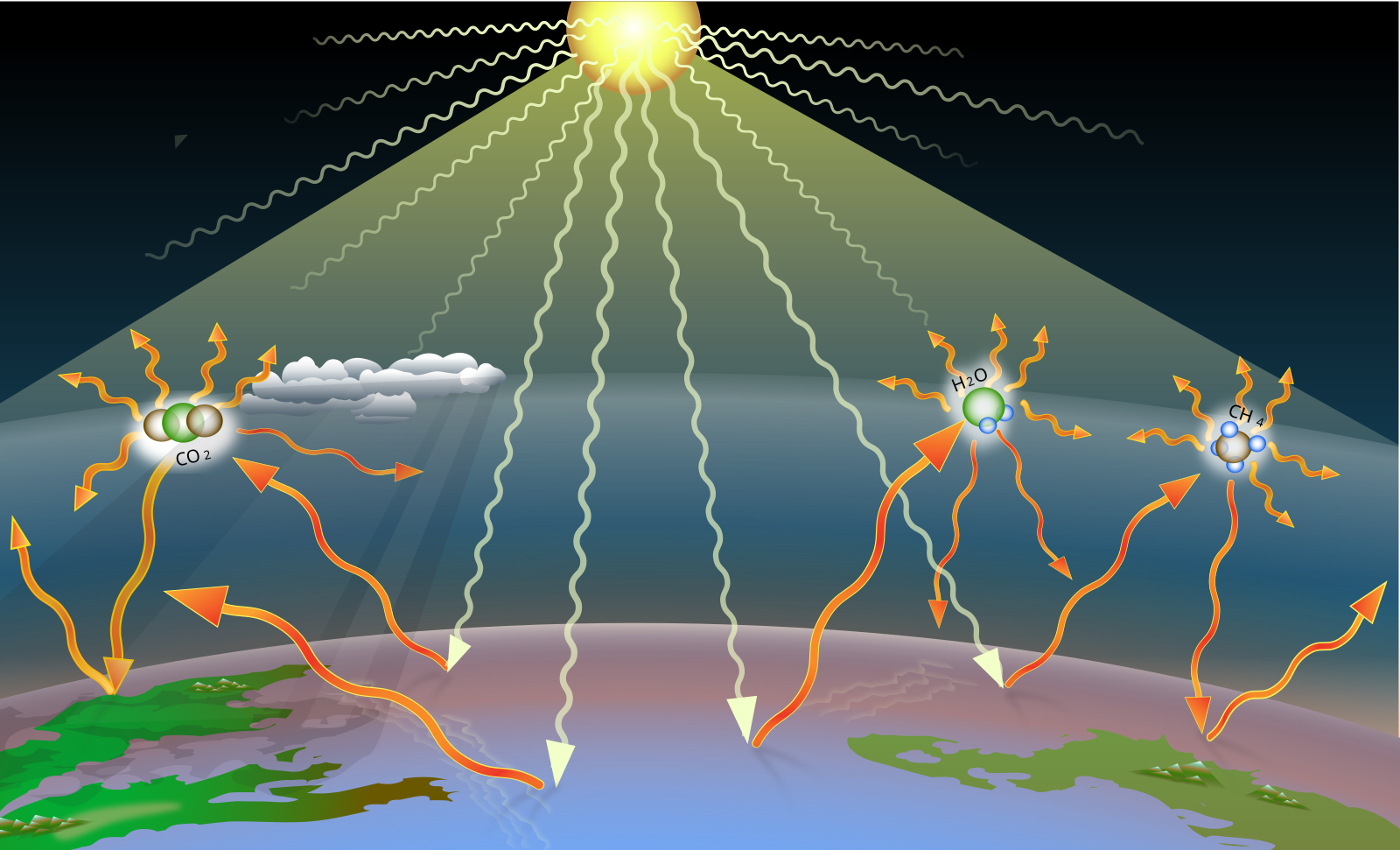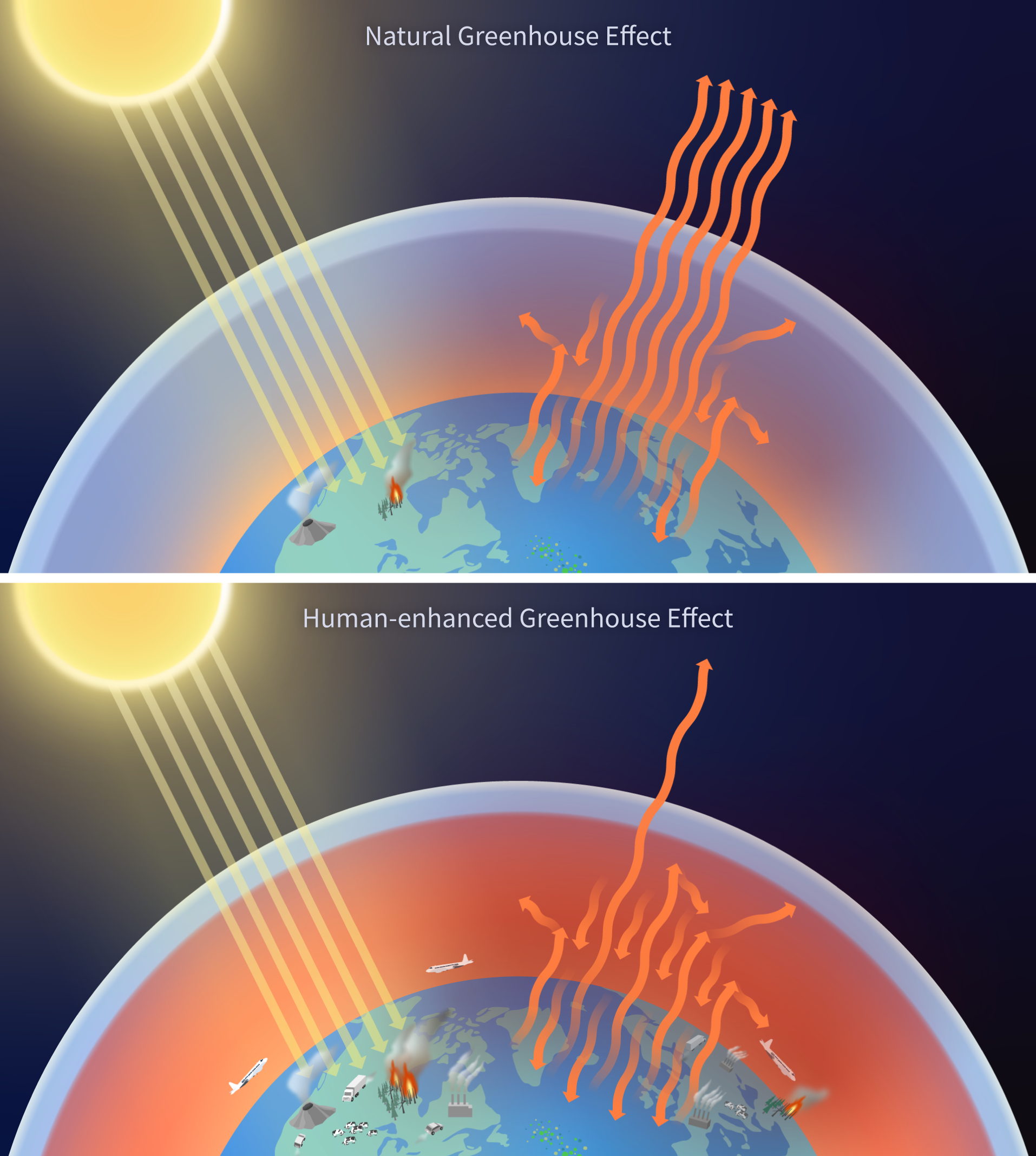IB Syllabus focus:
‘Human emissions of CO₂, CH₄ and N₂O strengthen the greenhouse effect, driving global warming and associated climate change.’
The enhanced greenhouse effect results from human activities increasing greenhouse gas emissions, which intensify Earth’s natural warming process. This drives global warming and wider climate change effects.
The Greenhouse Effect
Natural Greenhouse Effect
The natural greenhouse effect is essential for life. Without it, Earth’s average surface temperature would be around –18°C instead of +15°C. Naturally occurring greenhouse gases trap outgoing longwave radiation, keeping the planet habitable.

A schematic of the greenhouse effect: incoming shortwave sunlight is absorbed by the surface, which emits longwave infrared; greenhouse gases absorb and re-emit some of this energy, reducing the amount that escapes to space. The diagram focuses on core fluxes and labels with minimal extra detail, suitable for IB ESS. It does not quantify fluxes. Source.
Greenhouse effect: The process where certain gases in the atmosphere absorb and re-radiate infrared radiation, warming Earth’s surface and lower atmosphere.
Enhanced Greenhouse Effect
The enhanced greenhouse effect refers specifically to human-induced increases in greenhouse gases, causing additional warming beyond the natural baseline. This leads to altered weather patterns, sea-level rise, and ecosystem disruption.

Left: the natural greenhouse effect keeps Earth warm by absorbing and re-emitting outgoing longwave radiation. Right: human emissions of CO₂, CH₄ and N₂O intensify heat trapping, increasing positive radiative forcing and surface warming. Labels highlight major anthropogenic sources and the net reduction in heat escaping to space. Source.
Major Greenhouse Gases (GHGs)
Carbon Dioxide (CO₂)
Accounts for the largest share of anthropogenic GHG emissions.
Produced primarily by fossil fuel combustion, deforestation, and industrial processes.
Long atmospheric lifetime, remaining for hundreds of years.
Methane (CH₄)
Over 25 times more effective at trapping heat per molecule than CO₂ over a 100-year timescale.
Sources include livestock digestion, rice paddies, fossil fuel extraction, and landfills.
Shorter atmospheric lifetime than CO₂ (around 12 years), but highly potent.
Nitrous Oxide (N₂O)
Around 300 times more effective at trapping heat per molecule than CO₂.
Sources include agricultural fertilisers, biomass burning, and some industrial processes.
Long atmospheric lifetime, around 120 years.
Radiative forcing: The difference between incoming solar energy absorbed by Earth and the energy radiated back to space. Positive radiative forcing warms the climate, while negative forcing cools it.
The Role of Human Activity
Industrial Revolution and Beyond
Since the late 18th century, fossil fuel burning and industrialisation have driven rapid CO₂ increases.
Population growth has intensified demand for energy, food, and land.
Agriculture, particularly livestock farming and fertiliser use, significantly contributes to CH₄ and N₂O emissions.
Anthropogenic Strengthening of the Greenhouse Effect
Human activities alter the carbon cycle by transferring carbon from long-term geological stores (fossil fuels) into the active atmosphere. This upsets natural equilibrium, raising atmospheric concentrations.
Energy Balance (ΔE) = Incoming Solar Radiation – Outgoing Longwave Radiation
ΔE > 0 = Warming
ΔE < 0 = Cooling
Consequences of the Enhanced Greenhouse Effect
Global Warming
Global mean surface temperatures have risen by over 1°C since pre-industrial times.
Warming is not uniform; polar regions experience greater increases due to polar amplification.
Climate Change
The term climate change covers not only rising temperatures but also shifts in broader systems:
Changing precipitation patterns
More frequent and intense extreme weather events
Melting glaciers and sea ice
Rising sea levels due to thermal expansion and ice melt
Impacts on Natural Systems
Coral bleaching due to higher ocean temperatures and acidification
Species migration as habitats shift poleward or to higher elevations
Reduced biodiversity in vulnerable ecosystems
Impacts on Human Systems
Increased risks to agriculture from droughts and floods
Health challenges linked to heat stress and vector-borne diseases
Coastal communities threatened by inundation and storm surges
Feedback Mechanisms
Positive Feedbacks
Ice-albedo feedback: Melting ice reduces reflectivity, increasing heat absorption and accelerating warming.
Methane release: Thawing permafrost releases CH₄, amplifying warming.
Negative Feedbacks
Increased plant growth: Higher CO₂ levels can stimulate photosynthesis, acting as a carbon sink.
Cloud cover changes: Some clouds may reflect solar radiation, reducing warming.
Feedback: A process where an initial change triggers further changes, which can either amplify (positive feedback) or counteract (negative feedback) the original effect.
Key Points for IB Students
The enhanced greenhouse effect is driven by human emissions of CO₂, CH₄, and N₂O.
These gases differ in sources, potency, and atmospheric lifetimes, but together they alter Earth’s radiative balance.

Bar chart of GWP-100 values showing that methane and nitrous oxide warm the climate far more per unit mass than carbon dioxide over a century. Values are drawn from IPCC AR6 and allow comparison on a CO₂-equivalent basis. The visual includes additional gases not required by this subsubtopic. Source.
The impacts extend beyond warming, influencing ecosystems, human health, and global systems.
Understanding feedback mechanisms is crucial for predicting future climate dynamics.
FAQ
Direct effects occur when gases such as CO₂, CH₄, and N₂O absorb and re-radiate infrared radiation themselves.
Indirect effects involve processes triggered by these gases. For example, methane contributes to the formation of ozone in the troposphere, while N₂O affects stratospheric ozone chemistry. These secondary interactions add to overall warming.
Methane remains in the atmosphere for about 12 years, far shorter than CO₂, which can persist for centuries.
Despite its shorter lifetime, methane has a much higher warming potential over a 20-year period, making it a powerful short-term driver of climate change. Reducing methane emissions provides quicker climate benefits compared to CO₂ mitigation.
The use of nitrogen-based fertilisers increases soil microbial processes such as nitrification and denitrification, which release N₂O.
Additional sources include manure management and biomass burning.
N₂O has a global warming potential about 300 times that of CO₂.
Its long lifetime means agricultural emissions have persistent climate impacts.
The climate impact of a gas depends on both how efficiently it traps infrared radiation (radiative efficiency) and how long it remains in the atmosphere.
Methane: high efficiency, short lifetime
CO₂: lower efficiency, long lifetime
N₂O: high efficiency, very long lifetime
Together, these factors explain differences in global warming potential.
Human-added GHGs reduce the amount of outgoing longwave radiation escaping to space, producing positive radiative forcing.
This imbalance means Earth absorbs more energy than it releases.
Surface warms to restore balance.
Oceans absorb excess heat, delaying but not preventing warming.
Feedbacks such as ice melt further shift the balance toward warming.
Practice Questions
Question 1 (2 marks)
State two human activities that contribute to the enhanced greenhouse effect.
Mark Scheme:
Burning of fossil fuels / energy production (1 mark)
Deforestation (1 mark)
Agriculture / livestock production releasing methane (1 mark, up to 2 max)
Industrial processes (cement production, fertiliser use) (1 mark, up to 2 max)
Question 2 (5 marks)
Explain how human emissions of carbon dioxide (CO₂), methane (CH₄), and nitrous oxide (N₂O) strengthen the greenhouse effect, and outline one consequence for natural or human systems.
Mark Scheme:
Correct description of CO₂ as the most significant anthropogenic greenhouse gas with long atmospheric lifetime (1 mark)
Explanation that CH₄ has a higher warming potential than CO₂ per molecule, from sources such as livestock or fossil fuel extraction (1 mark)
Explanation that N₂O has very high warming potential, mainly from fertilisers or combustion (1 mark)
Clear link that these gases increase radiative forcing / trap more longwave radiation, thus intensifying the natural greenhouse effect (1 mark)
Consequence described: e.g., global temperature rise, sea-level rise, coral bleaching, increased droughts/floods, health impacts (1 mark)

